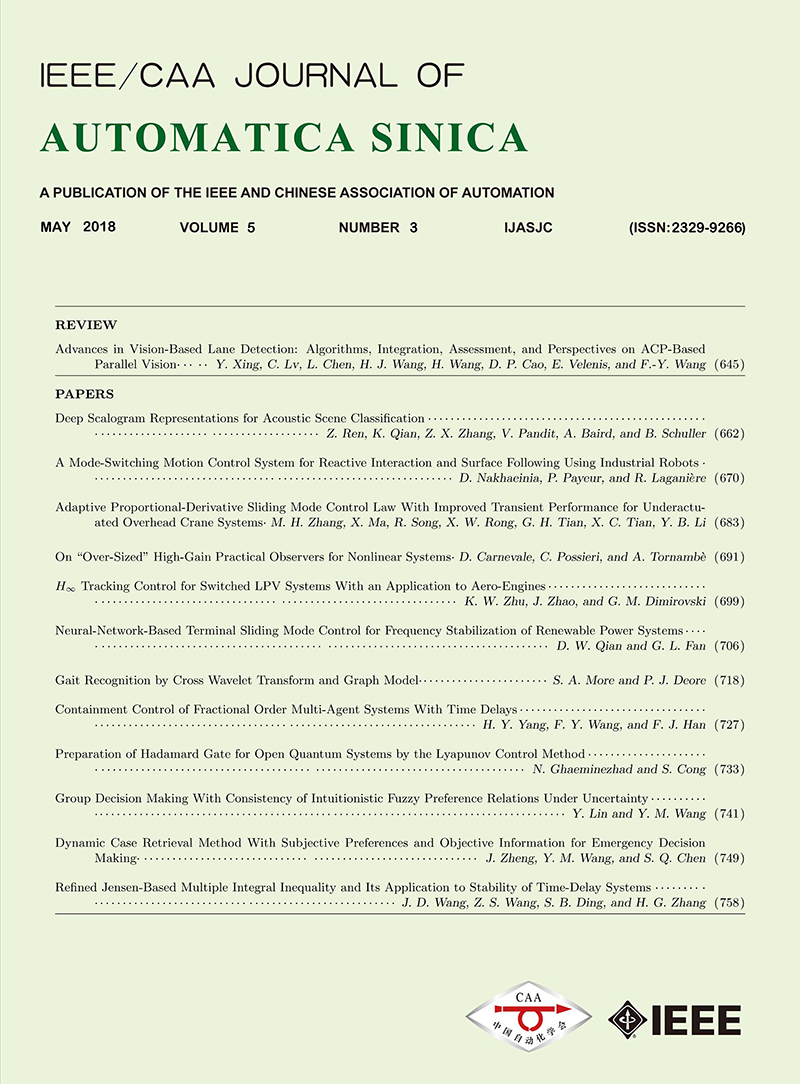 Volume 1
Issue 1
Volume 1
Issue 1
IEEE/CAA Journal of Automatica Sinica
| Citation: | Aolei Yang, Wasif Naeem and Minrui Fei, "Decentralised Formation Control and Stability Analysis for Multi-vehicle Cooperative Manoeuvre," IEEE/CAA J. of Autom. Sinica, vol. 1, no. 1, pp. 92-100, 2014. |

| [1] |
Murray R M. Recent research in cooperative control of multi-vehicle systems. Journal of Dynamic Systems, Measurement, and Control, 2007, 129(5):571-583
|
| [2] |
Turpin M, Michael N, Kumar V. Trajectory design and control for aggressive formation flight with quad-rotors. Autonomous Robots, 2012, 33(1-2):143-156
|
| [3] |
Monteiro S, Bicho E. Attractor dynamics approach to formation control:theory and application. Autonomous Robots, 2010, 29(3-4):331-355
|
| [4] |
Wang J L, Wu H N. Leader-following formation control of multi-agent systems under fixed and switching topologies. International Journal of Control, 2012, 85(6):695-705
|
| [5] |
Chen G, Lewis F L. Leader-following control for multiple inertial agents. International Journal of Robust and Nonlinear Control, 2011, 21(8):925-942
|
| [6] |
Mehrjerdi H, Ghommam J, Saad M. Nonlinear coordination control for a group of mobile robots using a virtual structure. Mechatronics, 2011, 21(7):1147-1155
|
| [7] |
Askari A, Mortazavi M, Talebi H. UAV formation control via the virtual structure approach. Journal of Aerospace Engineering, doi: 10.1061/(ASCE)AS.1943-5525.0000351
|
| [8] |
Xue D, Yao J, Chen G, Yu Y L. Formation control of networked multi-agent system. IET Control Theory and Application, 2010, 4(10):2168-2176
|
| [9] |
Fax J A, Murray R M. Information flow and cooperative control of vehicle formations. IEEE Transactions on Automatic Control, 2004, 49(9):1465-1476
|
| [10] |
Desai J P, Ostrowski J P, Kumar V. Modeling and control of formations of nonholonomic mobile robots. IEEE Transactions on Robotics and Automation, 2001, 17(6):905-908
|
| [11] |
Mesbahi M, Hadaegh F Y. Formation flying control of multiple spacecraft via graphs, matrix inequalities, and switching. Journal of Guidance, Control, and Dynamics, 2001, 24(2):369-377
|
| [12] |
Olfati-Saber R, Murray R M. Distributed structural stabilization and tracking for formations of dynamic multiagents. In:Proceedings of the 41st IEEE Conference on Decision and Control. Las Vegas, USA:IEEE, 2002. 209-215
|
| [13] |
Ogren P, Egerstedt M, Hu X M. A control Lyapunov function approach to multiagent coordination. IEEE Transactions on Robotics and Automation, 2002, 18(5):847-851
|
| [14] |
Hong Y G, Gao L X, Cheng D Z, Hu J P. Lyapunov-based approach to multiagent systems with switching jointly connected interconnection. IEEE Transactions on Automatic Control, 2007, 52(5):943-948
|
| [15] |
Feddema J T, Lewis C, Schoenwald D A. Decentralized control of cooperative robotic vehicles:theory and application. IEEE Transactions on Robotics and Automation, 2002, 18(5):852-864
|
| [16] |
Yang A L, Naeem W, Irwin G W, Li K. Novel decentralised formation control for unmanned vehicles. In:Proceedings of the 2012 IEEE Intelligent Vehicles Symposium (IV 2012). Alcalá de Henares, Spain:IEEE, 2012. 13-18
|
| [17] |
Yang A L, Naeem W, Irwin G W, Li K. A decentralised control strategy for formation flight of unmanned aerial vehicles. In:Proceedings of the 2012 UKACC International Conference on Control. Cardiff, UK:IEEE, 2012. 345-350
|
| [18] |
Yang A L, Naeem W, Irwin G W, Li K. Stability analysis and implementation of a decentralised formation control strategy for unmanned vehicles. IEEE Transactions on Control Systems Technology, doi: 10.1109/TCST.2013.2259168
|
| [19] |
Khalil H K. Nonlinear Systems (3rd edition). New Jersey:Prentice Hall, 2001
|
| [20] |
Marius Niculescu. AeroSim Aeronautical Simulation Block Set V1. 2, Users Guide. Oregon, US:Unmanned Dynamics, LLC, 2003
|
| [21] |
Šiljak D D, Stipanović D M. Robust stabilization of nonlinear systems:the LMI approach. Mathematical Problems in Engineering, 2000, 6(5):461-493
|